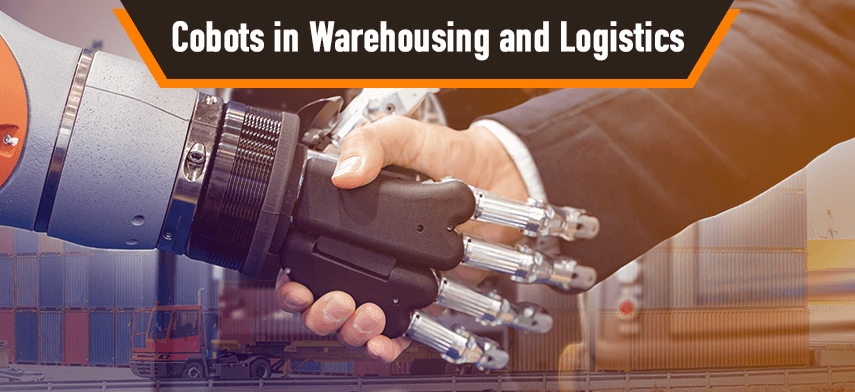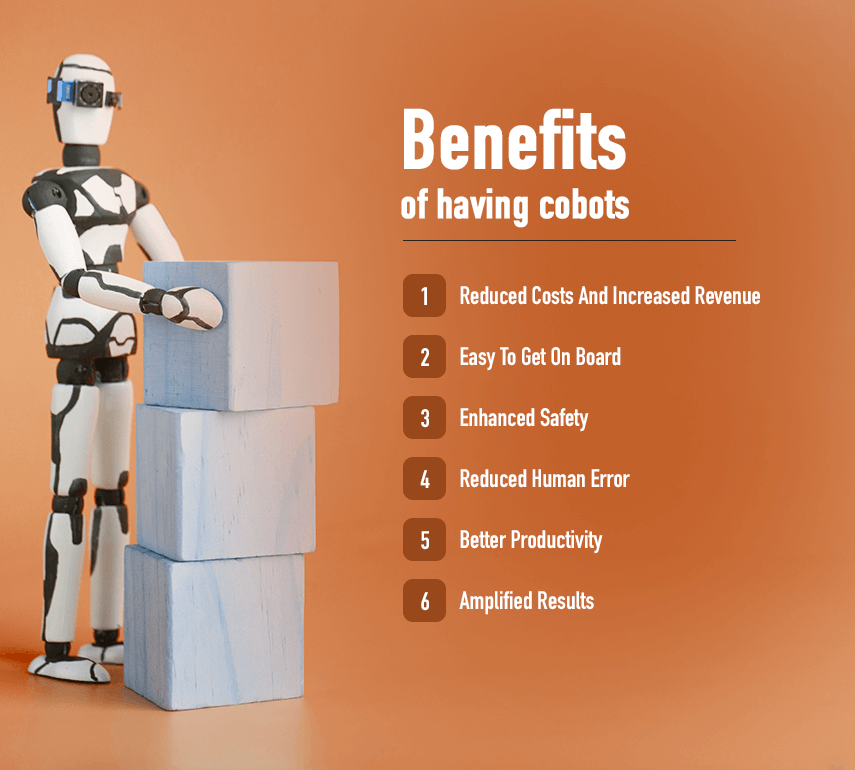From high fuel costs to the driver shortage and environmental concerns, the logistics industry faces several economic and social challenges. One of the recent developments in the sector that seems to be cutting down these hurdles is the emergence of Robots-as a-Service, also known as collaborative robots, or cobots. They help with facilitating cumbersome, time-consuming tasks, along with reducing the logistic costs and streamlining the supply chain. Furthermore, warehousing cobots are not a replacement of human labor, but an asset to augment the work and boost productivity.

This article talks about how warehouse cobots are playing a pivotal role in reshaping the logistics industry.
Current State Of Robotics In Logistics Industry
Robotics is yet to be streamlined in the logistics industry, and the upcoming five-year bracket seems to show a rise in the importance of cobots in logistics. However, in a survey, the automated warehouses are 76% more efficient, boosting the accuracy of inventory to 99% and more, with approximately 36% lesser labor costs.
This surge is directly linked with the robot unit shipments, which is likely to grow exponentially in the coming few years. For now, Amazon is the only renowned company that is known for its automated distribution centers, but other companies are also switching to automated warehousing, with safety and efficiency being the major concerns of the existing system.
At present, robots are being utilized for specific tasks, such as fastening screws in a battery pack or picking up items and keeping them to another place over and over again. Instead of replacing human jobs, cobots may create new jobs, in which manpower is required to work in accordance with their endurance and precision. And that is obvious; cobots are just robots that are capable of working with human dexterity and flexibility.
Benefits Of Having Cobots

Collaborative robots or cobots are refining the robot-human relationship across the entire logistics industry. Companies, irrespective of their size and type, are willing to invest in and acquire cobots and for rightful reasons. Here are the key benefits of having cobots by your side.
1 Reduced Costs And Increased Revenue
First things first, let’s talk about how cobots affect the costs and finances of a company. They might be a hefty initial investment, but the initial costs of cobots are quickly returned in the form of cost savings and improved productivity. Thus, you can realize a quick return on investment compared to other automated solutions.
Warehouse cobots help warehouses save money by optimizing human labor. As mentioned before, they are not a replacement for human workers but a component to boost productivity. For instance, cobots can utilize AI and ML to plan efficient picking routes in real-time, which reduces time and energy wasted on unnecessary walking. Thus, the associates will free up quickly and can focus on other crucial tasks.
2 Easy To Get On Board
One of the primary reasons why business prefers ditching new technologies is the daunting process of implementing them. Luckily, that is not the case with collaborative robots. Warehouse robots are quick and easy to install and can be trained as per your business requirements. Their software is easily programmable, enabling businesses to get cobots onboard within a few weeks.
In addition, the introduction and implementation of cobots in an organization do not require any changes to the infrastructure. Also, the intuitive feature operation makes them up and running faster than other automated solutions.
3 Enhanced Safety
Warehousing and logistics is an on-field industry, which is highly prone to injuries and accidents. Not only do on-job injuries hurt the workers, but they can also raise questions on your workplace safety, which can affect a company’s overall reputation. Moreover, injuries and accidents, apart from reducing productivity, also cost you in the form of compensations and healthcare expenses.
By implementing warehouse cobots, you reduce the physical workload of your workers, which reduces excessive labour work and body strains, thereby lowering their chances of getting injured. There are several warehouse facilities that include hazardous or delicate materials where a steady hand is required. Human labor is not only at risk but is prone to error as well. Cobots, on the other hand, are way more accurate in performing these tasks, along with being resistant to harm and injuries.
4 Reduced Human Error
Let’s address the topic of human error in detail. One attribute that makes us humans is that we all make mistakes every now and then. Although mistakes are bound to happen, sometimes they can be detrimental to business, profits, and reputation. One common mistake is the packing of wrong items, which can occur due to fatigue or distraction.
Cobots are almost perfect; not only do they guide users with their specific tasks, but they also have in-build control measures that assure all the procedures are concluded with the highest levels of accuracy.
5 Enhanced Productivity
Finally, cobots enhance productivity, a variable that most logistic companies struggle to achieve. They guide workers through their tasks, ensuring them to remain focused. Collaborative robots are also capable of picking and packaging more items in less time, without increasing the costs or posing the risks of injury. Thus, your staff can focus on core tasks and challenges, which directly adds to higher production and revenue.
6 Amplified Results
So, how do robots impact the supply chain? Nowadays, customer satisfaction is all about fast and free shipping; a goods-to-person picking system offers the foundation of meeting market demands with expedited fulfillment times.
Applications Of Warehouse Cobots
One of the significant challenges the logistics industry faces is the availability of high-quality, efficient labor. Finding skilled employees, along with taking care of their safety and productivity, can be a burdensome task for every organization. Here is how Robot as Service (RaaS) can perform human functions in the logistics industry.
Loading And Unloading
Most of the goods transported across countries are shipped in the standard containers, and to reduce transportation costs; these goods are stacked without using pallets in the ships. Post arrival to the port, these goods are manually unloaded. Not only is this process labor-intensive, but it is highly time-consuming too. To overcome this hurdle, robots like the Parcel Robot were introduced, which features a telescopic conveyor belt, robotic arm, chassis, grabber, and 3D laser scanner, which can facilitate the loading and unloading tasks without any human intervention.
Stationary Piece Picking
In traditional warehousing, workers walk around and organize all the items. Mobile robots can pick up shelves of goods and get them to a picker who can then pick as per the requirements. This process will continue with multiple robots recurrently coming in. Initially, this model had some issues, as robots were unclear about what to pick. But the newer robots feature vision systems, which ensures they are identifying and selecting the right product. An alternative to stationary piece picking has also been found, in which robots work exactly like humans by moving around the warehouse and picking up items.

Custom Packaging
During festive seasons or year ends, many items are sold with offers and discounts; most of these items need custom packaging. This task, however, can be difficult for robots as they are unable to judge the different sizes of the object that require packaging; they work alongside humans. It can also raise safety issues as robots need to be designed to work around humans. This challenge is overcome by collaborative robots, which are safe, have no sharp edges, and shut down instantly after bumping into something.
Sorting
Sorting is the process of identifying items on a conveyor system and taking them to specific destinations. Newer robots, such as Pegasus used by Amazon, are readily taking charge of the sortation process, thereby reducing human effort and involvement to a large extent.
Palletizing
Palletizing is another component of warehousing and logistics that is being facilitated with the help of robots. But, the traditional robots were costly and complex to set up and program. Cobots, on the other hand, turns out to be an excellent solution for light to medium duty palletizing applications because the rates are not too high. Moreover, they are simple to program, which makes them a great pick for automating the outbound shipping process.
Future Possibilities/opportunities
Cobots are considered as the future of work, not only in logistics but in industries like manufacturing and production as well.
As discussed earlier, more than 80 percent of warehouses and logistic companies are yet to implement automation in their operations. But lately, there has been a drift in the approach as many companies are readily working on a strategy to adopt and implement the capabilities of warehouse robotics. So, in the upcoming years, we can expect the number of companies using robotics to surge by a significant margin and, thus, the use of Robot as a Service (RaaS) in the logistics industry being streamlined.
The beauty of technology is that it never stops evolving, and we will witness a similar trend in the robotics sector as well. The transformation of traditional robots to AGVs (automated guided vehicles) and AMRs (autonomous mobile robots) is a realistic prediction, and there might be some visible changes by the end of 2025.
There can be a significant revolution in the future of collaborative robots. Although cobots are already simplifying and optimizing the warehousing procedures, they might undergo further advancements. For now, collaborative robots are a blend of a robot’s speed and precision, and a human’s knowledge, analysis, and decision. Shortly, we can expect them to become more “intelligent” and add more value to the logistics industry.
Wrapping up
Logistics and Warehousing is one of the first industries to streamline the use of robots. Although the share of companies that have fully integrated cobots in their workplace is low, most organizations are figuring out a way to implement Robot as a service (RaaS) in some way or the other. And, in the upcoming five to seven years, we can witness a massive wave of adoption of cobots in almost every logistics company.
Cobots offer significant benefits to the logistics industry; it takes care of cumbersome tasks such as packaging, sorting, and loading & unloading, enabling workers to free up some time and focus on more productive tasks. And, as technology grows, cobots will evolve and further enhance the efficiency and productivity of the logistics industry.

Author's Bio

Shailendra Sinhasane (Shail) is the co-founder and CEO of Mobisoft Infotech. He has been focused on cloud solutions, mobile strategy, cross-platform development, IoT innovations and advising healthcare startups in building scalable products.



